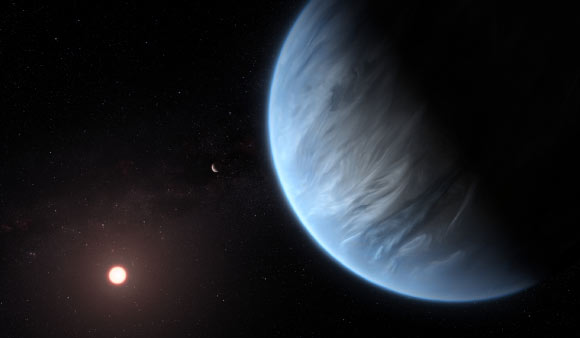Super-Earth Exoplanet K2-18b Could Have Right Conditions for Life | Astronomy – Sci-News.com
A team of astronomers from the Institute of Astronomy at the University of Cambridge, UK, has found K2-18b, a planet of almost nine Earth masses in orbit around the red dwarf K2-18, to be potentially habitable.

This artist’s impression shows planets K2-18b and c and their host star. Image credit: NASA / ESA / Hubble / M. Kornmesser.
K2-18 is an M-type star located some 111 light-years away in the constellation Leo.
Also known as EPIC 201912552, the star hosts two massive planets: K2-18b and c.
Discovered in 2015, K2-18b has a radius of 2.6 times that of Earth and is about 8.6 times as massive.
The planet orbits the parent star every 33 days at a distance of approximately 0.15 AU and has an Earth Similarity Index of 0.73.
In 2019, two different teams reported detection of water vapor in the hydrogen-rich atmosphere of K2-18b. However, the extent of the atmosphere and the conditions of the interior underneath remained unknown.
“Water vapor has been detected in the atmospheres of a number of exoplanets but, even if the planet is in the habitable zone, that doesn’t necessarily mean there are habitable conditions on the surface,” said Dr. Nikku Madhusudhan, lead author of the study.
“To establish the prospects for habitability, it is important to obtain a unified understanding of the interior and atmospheric conditions on the planet — in particular, whether liquid water can exist beneath the atmosphere.”
Given the large size of K2-18b, it has been suggested that it would be more like a smaller version of Neptune than a larger version of Earth.
A ‘mini-Neptune’ is expected to have a large hydrogen ‘envelope’ surrounding a layer of high-pressure water, with an inner core of rock and iron.
If the hydrogen envelope is too thick, the temperature and pressure at the surface of the water layer beneath would be far too great to support life.
Now, Dr. Madhusudhan and colleagues have shown that despite the size of K2-18b, its hydrogen envelope is not necessarily too thick and the water layer could have the right conditions to support life.
The astronomers used the existing observations of the atmosphere, as well as the mass and radius, to determine the composition and structure of both the atmosphere and interior using detailed numerical models and statistical methods to explain the data.
They confirmed the atmosphere to be hydrogen-rich with a significant amount of water vapor.
They also found that levels of other chemicals such as methane and ammonia were lower than expected for such an atmosphere.
Whether these levels can be attributed to biological processes remains to be seen.
The researchers then used the atmospheric properties as boundary conditions for models of the planetary interior.
They explored a wide range of models that could explain the atmospheric properties as well as the mass and radius of the planet.
This allowed them to obtain the range of possible conditions in the interior, including the extent of the hydrogen envelope and the temperatures and pressures in the water layer.
“We wanted to know the thickness of the hydrogen envelope — how deep the hydrogen goes,” said Matthew Nixon, co-author of the study.
“While this is a question with multiple solutions, we’ve shown that you don’t need much hydrogen to explain all the observations together.”
The scientists found that the maximum extent of the hydrogen envelope allowed by the data is around 6% of the planet’s mass, though most of the solutions require much less.
The minimum amount of hydrogen is about one-millionth by mass, similar to the mass fraction of the Earth’s atmosphere.
In particular, a number of scenarios allow for an ocean world, with liquid water below the atmosphere at pressures and temperatures similar to those found in Earth’s oceans.
The findings will be published in the Astrophysical Journal Letters.
_____
Nikku Madhusudhan et al. 2020. The interior and atmosphere of the habitable-zone exoplanet K2-18b. ApJL, in press; doi: 10.3847/2041-8213/ab7229






